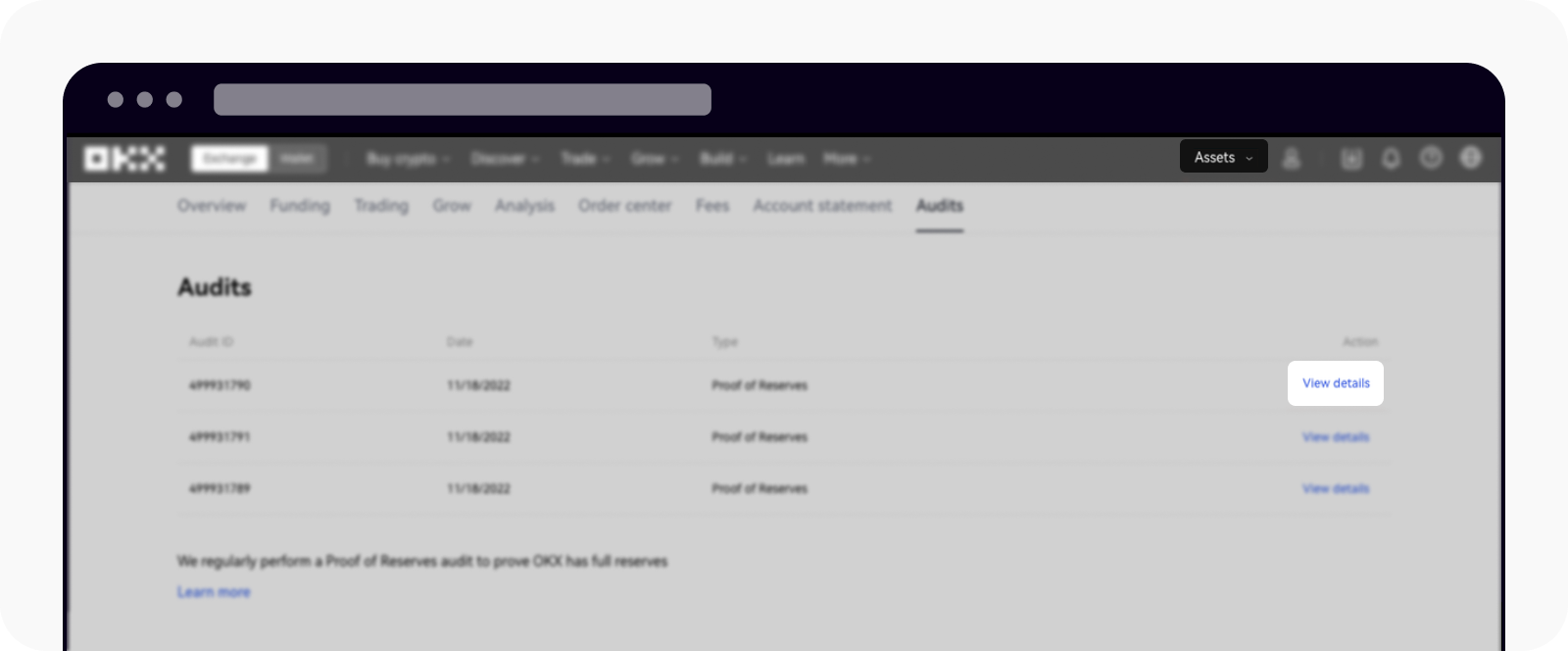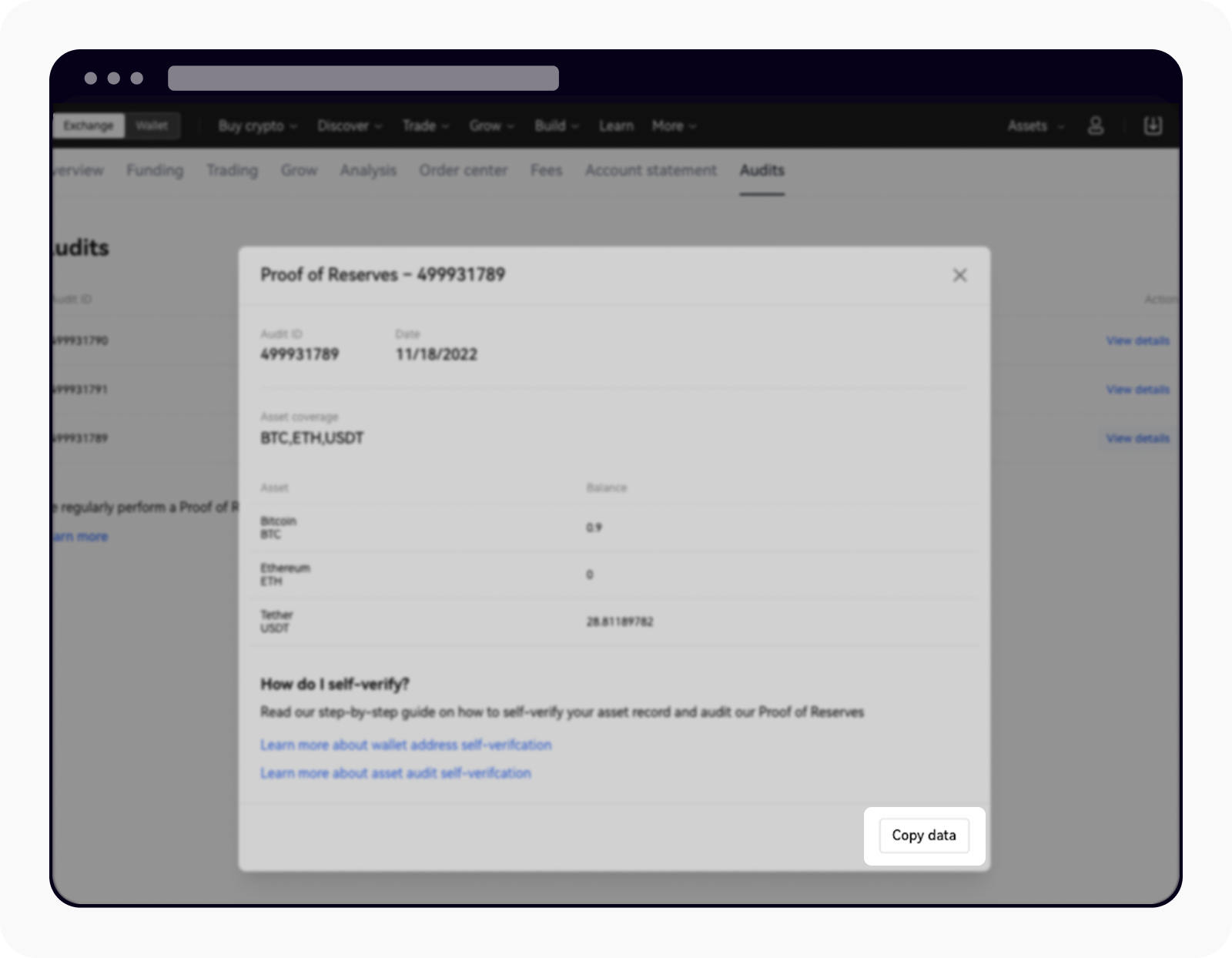How do I verify assets in the OKX Merkle tree? (Merkle Tree V1)
What's a Merkle Tree?
A Merkle Tree (or Hash Tree) is a data structure, which is normally a binary tree. It uses predefined functions to calculate hash value of a node from bottom up, to the top root node of the tree.
Node Information
Every tree node stores such information:
Hash value of the node
Crypto currency amount of a user captured by the audit snapshot (take BTC, ETH, USDT as an example)
hash value,{"BTC":"BTC amount","ETH":"ETH amount","USDT":"USDT amount"} be324cf06aee0616b4ec20c3,{"BTC":"1.023","ETH":"0","USDT":"20.2343322"}
Hash Rule
Leaf Nodes (except padding nodes)
hash=SHA256(nonce+balances)
OKX will assign one unique nonce for each user, which can be found on the user's audit page; balances is a json String composed of users' assets and amounts that were captured by the audit snapshot, for example: {"BTC":"1.023","ETH":"0","USDT":"20.2343322"} (NOTE: need to get rid of the trailing zeroes, and keep 8 decimals of precision)
Parent Nodes
hash of a parent node = SHA256(h1+h2+(h1 BTC amount+h2 BTC amount)+(h1 ETH amount+h2 ETH amount)+(h1 USDT amount+h2 USDT amount)+height)
h1 = Hash of the current node's left child node, h2 = Hash of the current node's right child node, audit_id = ID of the current audit, height = the height of node h1 (or h2) Definition of height: height of the bottom leaf node=1, height of a parent node=height of its child node + 1, root node has the maximum height
Padding Nodes Rule
To construct a full Merkle tree (a full binary tree), it requires 2^n leaf nodes, but the actual data might not meet such requirement and there could also be an odd number of data. In such circumstances, if node k doesn't have sibling nodes, one sibling node k' will be automatically generated as a padding node, such that hash(k')=hash(k), and the asset amounts will be set to 0 for all currencies. For example:
| Hash | Balances |
|---|---|
| h1 | {"BTC": 1, "ETH": 1,"USDT": 1} |
| h2 | {"BTC": 1, "ETH": 2,"USDT": 3} |
| h3 | {"BTC": 1, "ETH": 2,"USDT": 4} |
In this example, padding node h4=h3, and balances stored in the node is {"BTC": 0, "ETH": 0,"USDT": 0} as shown in the image below (green node):

hash of a parent node = SHA256(h1+h2+(h1 BTC amount+h2 BTC amount)+(h1 ETH amount+h2 ETH amount)+(h1 USDT amount+h2 USDT amount)+height) So: h6 = SHA256(h3 + h4 + (1+0)+(2+0)+(4+0)+height)
How do I verify if my assets are included in the OKX Merkle tree?
Verification theory
Based on the definition of OKX merkle tree, you can calculate the hash value of a parent node from bottom up based on its left child and right child nodes, all the way till you get the hash value of the root node, and then you can compare the calculated hash value of the root node with the one collected from the merkle tree path root node, if they're identical, the verification passes, and vice versa.
Example: refer to the image above and json text below, based on user's self node h3 and provided its sibling node h4, the hash of their parent node h6 can be calculated, and provided h6's sibling node h5, the hash of their parent node h7 can be calculated, then compare h7's hash value with the one collected in the merkle tree path root node and see whether they're identical to complete the verification process.
Merkle tree path data json text:
{ "self": { "balances": { "BTC": "1", "ETH": "1", "USDT": "1" }, "nonce": "aa8442ee975df827dc14e527e3ea01db71fe5a6cfe867d77f6a4148fc492743c", "hash": "ca080cc4b04630c9e667e3177be7b093af743101a300cd737dd2da6dbe801be6", "type": 1, "height": 1 }, "path": [{ "balances": { "BTC": "1", "ETH": "2", "USDT": "3" }, "hash": "7d16e6b5203299b85498aa35b964c83903a933d549f99ff3ca8b20c243c2be3e", "type": 2, "height": 1 }, { "balances": { "BTC": "1", "ETH": "2", "USDT": "4" }, "hash": "4d6376b3a51693be961dd402b620c3f2536cb3f7275629fa23e2d1c6c7b319db", "type": 2, "height": 2 }, { "balances": { "BTC": "3", "ETH": "5", "USDT": "8" }, "hash": "af1787033e8d32d600e2e40dc616c1f8d4271e1c182ed57b6e9585e1ac5aa959", "type": 3, "height": 3 }] }
Verification steps
1. To verify if the asset balance of your account has been included as a Merkle leaf, log in to your OKX account, select Assets and visit Audits to view recent audits, select View details to view your audit data.

Select Assets and View details for better data audit understanding 2. You can also manually verify your assets in the Merkle tree by following the steps in our guide. Get the data you need for manual verification by selecting Copy data.

Select Copy data for the manual verification process 3. After selecting Copy data, open the text editor (for example, notebook), then paste and save the json String as a json file. Operational steps: Mac: Open the terminal, enter command touch merkle_proof_file.json, and then a json file will be created. The file is saved in the system desk by default. You can open Finder and search for merkle_proof_file.json to find this file. Open this json file, paste the copied data, and save it. Windows: Double-click to open a text editor (for example, notebook), paste the data and save it as a json file. In our case, we name the file merkle_proof_file.json. Merkle tree path data json text is shown as below:
{ "self": { "balances": { "BTC": "1", "ETH": "1", "USDT": "1" }, "nonce": "aa8442ee975df827dc14e527e3ea01db71fe5a6cfe867d77f6a4148fc492743c", "hash": "ca080cc4b04630c9e667e3177be7b093af743101a300cd737dd2da6dbe801be6", "type": 1, "height": 1 }, "path": [{ "balances": { "BTC": "1", "ETH": "2", "USDT": "3" }, "hash": "7d16e6b5203299b85498aa35b964c83903a933d549f99ff3ca8b20c243c2be3e", "type": 2, "height": 1 }, { "balances": { "BTC": "1", "ETH": "2", "USDT": "4" }, "hash": "4d6376b3a51693be961dd402b620c3f2536cb3f7275629fa23e2d1c6c7b319db", "type": 2, "height": 2 }, { "balances": { "BTC": "3", "ETH": "5", "USDT": "8" }, "hash": "af1787033e8d32d600e2e40dc616c1f8d4271e1c182ed57b6e9585e1ac5aa959", "type": 3, "height": 3 }] }
Download the OKX open-source verification tool (MerkleValidator)
Save OKX open-source verification tool (MerkleValidator) and the data file (merkle_proof_file.json) in the same folder. In this case, the tool and the data file are placed under the folder Downloads, and named proof-of-reserves, as shown below:

6. Open the terminal application (for Mac: Terminal while Windows: Command Prompt) 7. Run the command and locate the directory of the downloaded folder. In our case, enter the command: cd ~/Downloads/proof-of-reserve 8. Type the command below and enter to start the verification: Mac: ./MerkleValidator --merkle_proof_file merkle_proof_file.json Windows: MerkleValidator.exe --merkle_proof_file merkle_proof_file.json Note: if you're using Mac and encounter a dialog box of "cannot open the tools because the developer cannot be verified", you may go to System Settings > Privacy & Security > Security > Select the App Store and identified developers at the Security section to Allow the [tool] 9. Check the result If the verification passes, a result showing Merkle tree path validation passed will be shown as below:

If the verification fails, a result showing Merkle tree path validation failed will be shown as below:

10. You can also refer to the code of the OKX open-source verification tool (MerkleValidator) and OKX merkle tree definition, write program yourself to verify that your assets are captured by the merkle tree built from the audit snapshot, using the merkle tree path data collected in step 2.